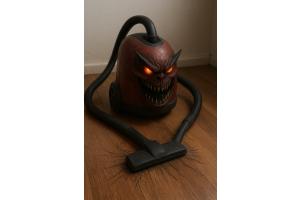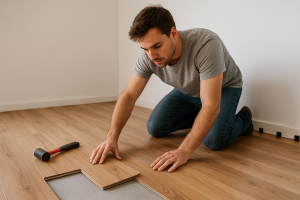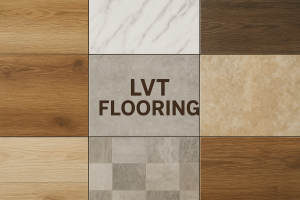
The floor really is lava if you don’t really know what you are doing.
Let’s start with the answer you want to hear. Yes, engineered wood flooring can be sanded, but – and it’s a big but – it all revolves around certain criteria. For instance, how many times has it been sanded before? Can the wood therefore be sanded without losing integrity?
In fact, have you got a top layer thick enough to even think about sanding things down?
The difference between success and crying into a pile of sawdust depends on a series of juicy details. Just like any part of home improvement, the devil’s in the detail and what’s done can rarely be undone without considerable cost. So, let’s break it down and make sure you don’t reduce your beautiful planks into a fine powder, laced with regret.
What exactly is engineered wood flooring?
First – what kind of floor have you actually got?
Not all laminate flooring is made from the same material. The majority of flooring panels are crafted from High-Density Fibreboard (HDF), and HDF doesn’t take kindly to being manipulated.
However, if you have engineered wood flooring beneath your feet, the situation is different. Akin to the cool cousin of solid hardwood, this stuff is made from layers of the real deal. Unlike solid hardwood (which is a single, solid plank of wood all the way through), engineered wood is basically a cake made of lumber.
Engineered wood flooring has real hardwood veneer on top (the wear layer), and plywood and/or high-density fibreboard beneath that, alongside other wood products that are stacked in layers for strength, stability and an ability to shrug off the pressure of daily life - like when your toddler drops an iPad corner-first from the kitchen counter.
People opt for this kind of flooring as it’s less prone to warping when presented with moisture and temperature changes. It often comes prefinished, and it can be installed in more places than solid wood. You can float it, glue it, nail it, or click it together like IKEA flooring made by actual carpenters.
But here’s the rub (and this is where sanding comes in). That lovely top layer of real wood is limited. And when it’s gone, it’s gone. You’ve effectively ruined your floor, and nobody wants that.
Your floor’s sanding budget
Want to know if you can sand your engineered wood floor? The quick answer is simple – measure the wear layer. This thin slice of real wood is the only part you can sand, delve any further and you’ve decapitated your flooring.
Here’s the breakdown you require.
If it’s less than 2mm, don’t even think about sanding. Best to spot treat only. You have been warned!
Should your flooring offer 2-3mm of wear layer, you’ll maybe get one light sanding. We’d recommend utilising some professional help to ensure nothing untoward occurs.
If you are lucky enough to walk upon boards with 4-4mm of thickness, then we’re talking one solid sanding, perhaps two if you’re careful.
Boasting 4-6mm worth? You’re in hardwood heaven. Sand it like you mean it; two, maybe even three times over the life of the floor.
However, keep this in mind. Just because you can sand a 3mm wear layer doesn’t mean you should be doing it every time your dog skids across the floor like he’s doing the moonwalk. Sanding takes off millimetres. You only get so many chances. Choose wisely.
How do I know my wear layer thickness?
If you’re lucky enough to still have the original product specs or the box it came in (in which case, you’re more organised than 95% of humanity), it should tell you right there. Look for something like “3mm oak veneer.”
If not? You’ve got two choices.
Call the manufacturer – If you know the brand and model, this is the easiest way to get solid info. If you bought the flooring from us, then contact our helpful customer service team and they’ll be able to sort you out.
Otherwise, pull up a floor vent or transition strip. This will let you see a cross-section of the plank, a bit like a tree ring, but with more adhesives. Once you can examine the depth, if it’s only a whisper-thin sliver of wood before the layers underneath, don’t break out the sanding equipment. You’ll need to leave it as it is, or replace the panel(s).
Why would I want to sand the floor in the first place?
Sanding isn’t a hobby. It’s a means to a beautiful, freshly refinished end. Rather than splashing out on a whole new set of laminate panels or engineered wood flooring, sanding can remove scratches and scuffs and bring the older material back to shiny life.
Dents and dings? Old finish or discoloration due to age? Gauges from wear and tear? Your past sins can be sanded into oblivion, and then stained and sealed all over again. We like to believe that it’s a wooden phoenix rising from the marked chaos of party mishaps and dragged chairs, but to everyone else, it’s a chance to save some money and prolong your flooring investment.
The do’s and absolutely do-not-do’s of sanding
Hey, now. It’s your flooring. If you are hellbent on sanding, then there’s a few ideals you should follow. But be warned, sanding engineered wood is not a job for the overconfident weekend warrior with a rented belt sander and dreams of Youtube stardom. Here’s the lowdown.
Things to do:
- Use a professional floor sander (the human, not the machine).
- Spot test a small area first.
- Use light sanding techniques—especially with thinner wear layers.
- Vacuum thoroughly between sanding passes.
- Choose a compatible finish—polyurethane, hardwax oil, or whatever matches the original.
Things not to do:
- Sand below the wear layer. You’ll hit the plywood and suddenly your “refinished floor” looks like something out of a survival shelter.
- Sand a floor that’s been heavily beveled unless you like weird dips and sad lines.
- Try to “just take a little more off” to get that one last scratch. That scratch will turn into a story you tell your therapist.
- Skip the grain direction—always sand with the grain, or it’ll look like a bear tried to dig its way through your dining room.
Alternatives to sanding?
If the engineered wood flooring simply can’t be sanded, or if the process remains one that puts you off, then don’t panic. There are other options should sanding be off the table.
Opting to rescreen and recoat the flooring would make a sensible next decision. This is like a gentle exfoliation. Light abrasion (screening) and a new top coat can refresh dull finishes without removing any real wood, and eliminating the worry around over-sanding and destroying the floor.
Touch-up kits are also available, perfect for minor scratches and concealing light damage from daily life. Then there’s the good-ol’ rug, where you can hide the damage and call it design. The perfect shortcut. Yet, as rugs can slip on your laminate and wood flooring (especially when polished or cleaned…or freshly sanded…), we wouldn’t feel inclined to recommend this without the proper precautions; such as grips or glue.
TL;DR
Yes, you can sand engineered wood flooring if the wear layer is thick enough.
No, you shouldn’t attempt it unless you know exactly what you’re doing—or you’re hiring someone who does.
Sometimes, the better path is a screen-and-recoat, touch-up, or just learning to love the “vintage patina” (a.k.a. battle scars).
Treat your engineered wood floor with respect. It may not be solid all the way through, but it’s got a strong core and a beautiful face—just like you after a long week.
Trust the wood, but verify the thickness.
Need help figuring out if your floor is a sanding candidate? We’ve got your back (and your baseboards). Drop your floor specs or photos anytime to our team. They’ll read them like tea leaves made of oak.












